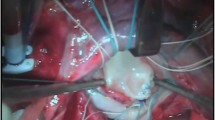Abstract
We aimed to evaluate the predictors of the severity of chronic rheumatic valvar disease. The long term follow-up records of 139 patients with chronic rheumatic carditis were reviewed. Children were followed-up on an outpatient basis for a period ranging from 1–16 years (5.0 ± 3.7 years). Mitral regurgitation either isolated (51%, n=71) or combined with aortic regurgitation (AR) (49%, n=68) was observed in all cases of the initial attack of rheumatic carditis. AR at initial attack of the rheumatic carditis was found to be affected by gender (AR was more associated with males, p = 0.032), combined mitral and aortic regurgitation (CMAR), and presence of MR at initial attack (p = 0.000 and p = 0.012, respectively) with univariate analysis. The effect of CMAR on AR at initial attack was also significant by multivariate analysis (p = 0.000). CMAR, MR, and AR at initial attack had significant effects on CMAR at final evaluation (p = 0.000, p = 0.020, and p = 0.000, respectively) in univariate analysis. Multivariate analysis revealed the significant effects of CMAR and MR at initial attack on CMAR at final evaluation (p = 0.000 and p = 0.005, respectively). Univariate analysis showed that MR and AR at initial attack, and CMAR at final evaluation, had significant effects on MR at final evaluation (p = 0.000, p = 0.029, and p = 0.000, respectively). MR at initial attack and CMAR at final evaluation had significant effects on MR at final evaluation with multivariate analysis (p = 0.001 and p = 0.003, respectively). AR at final evaluation was affected by CMAR and AR at initial attack (p = 0.000 and p = 0.000, respectively), and CMAR and MR at final evaluation (p = 0.000 and p = 0.000, respectively) with both univariate and multivariate analysis. Mitral valve prolapsus was more common in patients with a longer duration (37.5%, 6 out of 16) than those with a shorter duration (11%, 14 out of 123) and the difference was significant (p = 0.020). In conclusion, the initial severity of valve involvement and the presence of CMAR at initial attack were found to be the best predictors for the severity of chronic rheumatic valvar disease in this study.
Similar content being viewed by others
Abbreviations
- MR:
-
Mitral regurgitation
- AR:
-
Aortic regurgitation
- CMAR:
-
Combined mitral & aortic regurgitation
References
Albert DA, Harel L, Karrison T (1995) The treatment of rheumatic carditis: a review and meta-analysis. Medicine (Baltimore) 74:1–12. doi:10.1097/00005792-199501000-00001
Atalay S, Ucar T, Ozcelik N, Ekici F, Tutar E (2007) Echocardiographic evaluation of mitral valve in patients with pure rheumatic mitral regurgitation. Turk J Pediatr 49:148–153
Baumgartner H, Kratzer H, Helmreich G, Kühn P (1988) Quantitation of aortic regurgitation by colour coded cross-sectional Doppler echocardiography. Eur Heart J 9:380–387
Cilliers AM, Manyemba J, Saloojee H (2003) Anti-inflammatory treatment for carditis in acute rheumatic fever. Cochrane Database of Systematic Reviews 2:CD003176
Cilliers AM (2006) Rheumatic fever and its management. BMJ 333:1153–1156. doi:10.1136/bmj.39031.420637.BE
Herdy GV, Pinto CA, Olivaes MC, Carvalho EA, Tchou H, Cosendey R et al (1999) Rheumatic carditis treated with high doses of pulsetherapy methylprednisolone. Results in 70 children over 12 years. Arq Bras Cardiol 72:601–606. doi:10.1590/S0066-782X1999000500007
Karaaslan S, Oran B, Reisli I, Erkul I (2000) Acute rheumatic fever in Konya, Turkey. Pediatr Int 42:71–75. doi:10.1046/j.1442-200x.2000.01180.x
Karademir S, Demirceken F, Atalay S, Demircin G, Sipahi T, Tezic T (1994) Acute rheumatic fever in children in the Ankara area in 1990–1992 and comparison with a previous study in 1980–1989. Acta Paediatr 83:862–865. doi:10.1111/j.1651-2227.1994.tb13158.x
Kumar R (1995) Controlling rheumatic heart disease in developing countries. World Health Forum 16:47–51
Meira ZM, Goulart EM, Colosimo EA, Mota CC (2005) Long term follow up of rheumatic fever and predictors of severe rheumatic valvar disease in Brazilian children and adolescents. Heart 91:1019–1022. doi:10.1136/hrt.2004.042762
Miyatake K, Izumi S, Okamoto M, Kinoshita N, Asonuma H, Nakagawa H et al (1986) Semiquantitative grading of severity of mitral regurgitation by real-time two-dimensional Doppler flow imaging technique. J Am Coll Cardiol 7:82–88
National Heart Foundation of Australia (RF/RHD guideline development working group) and the Cardiac Society of Australia and New Zealand (2006) Diagnosis and management of acute rheumatic fever and rheumatic heart disease in Australia—an evidence-based review. 2006:44–48. http://www.heartfoundation.org.au/. Accessed 17 June 2008
Ozer S, Hallioglu O, Ozkutlu S, Celiker A, Alehan D, Karagoz T (2005) Childhood acute rheumatic fever in Ankara, Turkey. Turk J Pediatr 47:120–124
Ozkutlu S, Hallioglu O, Ayabakan C (2003) Evaluation of subclinical valvar disease in patients with rheumatic fever. Cardiol Young 13:495–499
WHO Study Group (1988) Rheumatic fever and rheumatic heart disease. World Health Organ Tech Rep Ser 764:1–58
Saraclar M, Ertugrul A, Ozme S (1978) Akut romatizmal ateş insidansı ve romatizmal kalp hastalıklan prevalansı. Turk Kardiyol Dern Ars 7:50–54 (in Turkish)
American Heart Association (1965) The natural history of rheumatic fever and rheumatic heart disease: ten-year report of a cooperative clinical trial of ACTH, cortisone, and aspirin. Circulation 32:457–476
Tompkins DG, Boxerbaum B, Liebman J (1972) Long-term prognosis of rheumatic fever patients receiving regular intramuscular benzathine penicillin. Circulation 45:543–551
Uziel Y, Hashkes PJ, Kassem E, Padeh S, Goldman R, Wolach B (2000) The use of naproxen in the treatment of children with rheumatic fever. J Pediatr 137:269–271. doi:10.1067/mpd.2000.107158
Vasan RS, Shrivastava S, Vijayakumar M, Narang R, Lister BC, Narula J (1996) Echocardiographic evaluation of patients with acute rheumatic fever and rheumatic carditis. Circulation 94:73–82
Wisenbaugh T, Skudicky D, Sareli P (1994) Prediction of outcome after valve replacement for rheumatic mitral regurgitation in the era of chordal preservation. Circulation 89:191–197
Wu MH, Lue HC, Wang JK, Wu JM (1994) Implications of mitral valve prolapse in children with rheumatic mitral regurgitation. J Am Coll Cardiol 23:1199–1203
Author information
Authors and Affiliations
Corresponding author
Rights and permissions
About this article
Cite this article
Yavuz, T., Nisli, K., Oner, N. et al. Long term follow-up results of 139 Turkish children and adolescents with rheumatic heart disease. Eur J Pediatr 167, 1321–1326 (2008). https://doi.org/10.1007/s00431-008-0799-6
Received:
Revised:
Accepted:
Published:
Issue Date:
DOI: https://doi.org/10.1007/s00431-008-0799-6




